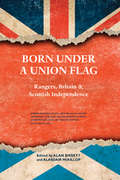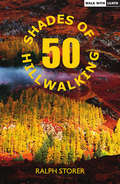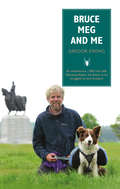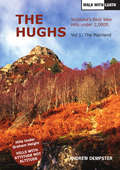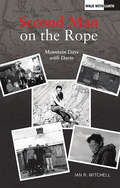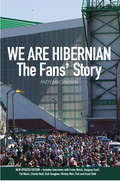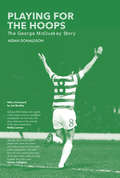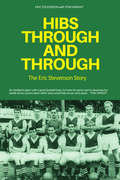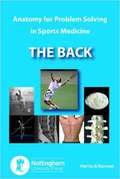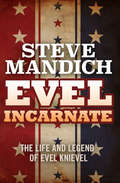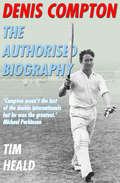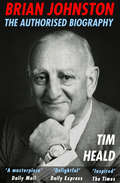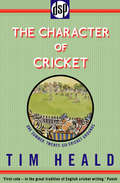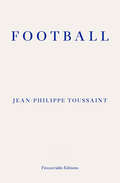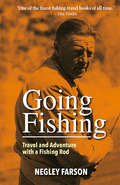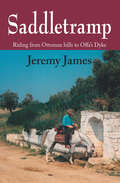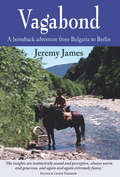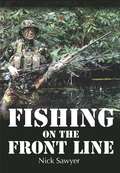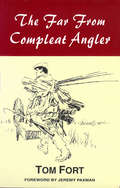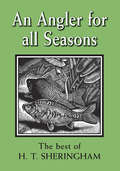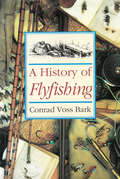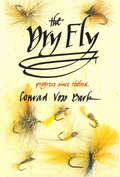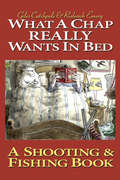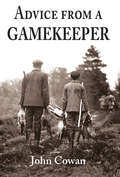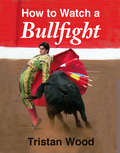- Table View
- List View
Born Under a Union Flag: Rangers, the Union and Scottish Independence
by Alan Bissett Alasdair McKillopA book about the relationship of a football club to a political decision? On one level this is madness. But in Scotland it makes perfect sense. What do Rangers mean to Scotland and what does Scotland mean to Rangers? What do Rangers mean to Britain and what does Britain mean to Rangers? How does the club and the game interact with the world around it? Questioning how British and Scottish identities fit into supporting Rangers, Born Under the Union Flag provides the first solid exploration of the relationship between sport and national identity. Well-known and informed contributors from both sides of the independence debate, including Harry Reid, Iain Duff, and Will McLeish, all lend their disparate viewpoints this book, showing just how nuanced - and difficult - the discussion really is. A must-read for anyone interested in Rangers, the history of Scottish football, or the independence debate. Like a great football match, when the final whistle is blown, the players will shake hands and move on. If they have any sense, the winners will be magnanimous in victory; the losers will rue the day but accept the result nonetheless. I guess the one thing neither side wants is a draw and a replay. But that's up to the voters.
50 Shades of Hillwalking
by Ralph StorerIn 50 Shades of Hillwalking, Ralph Storer takes a quirky look at the peculiar pursuit of messing about on mountains and presents us with 50 personal hillwalking experiences. Walking, climbing, mountain biking, caving - Ralph has tried it all, but admits to expertise only in the lost art of 'festering'. With room also for contemplation and argument, his inimitable 50 Shades will amuse, inspire and inform.Follow in his footsteps as he roves from the Lake District to the Alps, from Snowdonia to Scandinavia, and from the Scottish Highlands to the deserts and canyons of America. Warm to his intrepid exploits of derring-do as he gets snowbound in a tent, gets stuck on ice falls and in caves, and falls off mountain bikes and down sand dunes.Culled from not-yet-a-lifetime of eclectic escapades both at home and abroad, brought to life by carefully selected images, this highly entertaining collection of stories will resonate with anyone whose aspirations outstrip their ability.PRAISE FOR RALPH STORER:His books are exceptional' he subverts the guidebook completely.THE ANGRY CORRIEStorer is happy to share numerous irreverent insights into the hills, and this acts as a timely reminder that walking should be primarily about enjoyment of the great outdoors.ABERDEEN PRESS AND JOURNALA treat for all hillwalkers active or chair bound' Ralph Storer rambles over all aspects of enjoying and suffering, not only Scottish, but the world's hills.SCOTS INDEPENDENT on The Joy of Hillwalking
Bruce, Meg and Me: An adventurous 1,000 mile walk following Robert the Bruce as he struggled to save Scotland
by Gregor EwingCraving an escape from everyday life, Gregor Ewing writes a personal account of his 1,000 mile walk over nine weeks with collie Meg that takes them through Northern Ireland and the central belt of Scotland, literally following in Robert the Bruce’s footsteps. From Kintyre, Arran and Ardrossan north to Ayr through Glasgow to Fort William and Elgin, south to Inverurie, Aberdeen and Dundee, over the Forth to Edinburgh and Berwick upon Tweed then east through Roxburghshire to Bannockburn, Gregor frames his expedition with historical background that follows Robert the Bruce’s journey to start a campaign which led to his famous victory seven years later.
The Hughs: Scotland's Best Wee Hills Under 2,000 feet (The\hughs Ser. #1)
by Andrew DempsterAndrew Dempster has 40 years’ experience of hillwalking the length and breadth of Scotland. Author of several climbing books, including the first guidebook to the Grahams, in this volume he identifies the best wee hills on the Scottish mainland.MUNRO at least 3,000ft highCORBETT 2,500–3,000ft high with a prominence of at least 500ft GRAHAM 2,000–2,499ft high with a drop of at least 150 metresHUGH (Hill Under Graham Height): under 2,000ft with exceptional characterThe Hughs all offer rewarding – and often stunning – climbs and views. Some are already popular. Many await discovery. Each one has great character. That is what the Hughs are all about.vFrom Arthur’s Seat in Edinburgh to An Grianan in the far north, from Ben Hiant in the west to Bennachie in the east, the Hughs are a phenomenally diverse range of hills, stretching to all points of the compass. Accessible to people of any age, the Hughs are not defined by the sterile logic of relative height – they are a choice of the heart.
Second Man on the Rope: Mountain Days with Davie
by Ian R. MitchellWhat are the rules of etiquette in a bothy full of strangers?How cold, exactly, can a Scottish summer get?And how many cans of beer can a man carry whilst fording a swollen river?Second Man on the Rope tackles all these questions and more, a celebrating Scotland’s mountains come sun, sleet or snow, through the stories of a great climbing partnership.Ranging from the Cairngorms to Glencoe, from Nevis to Knoydart and from the Cuillin to the Cobbler, this book weaves the story of a friendship amongst witty – and often alarming – tales of mountaineering mishaps. These richly entertaining tales will delight all who love the Scottish hills – be they mountaineers, day-outers, Munro-baggers (like the author) or merely armchair ramblers.Written with a wealth of knowledge, this mountaineering classic is a warm and witty celebration of friendship, forged over many years, between the author and his ‘first man’ – Davie. Together they form one of the great double acts of climbing literature. They face with humour and fortitude all that the mountains can pit against them – winter avalanches, raging rivers, rats in bothies and Brummies in baseball boots.
We are Hibernian: The Fans' Story
by Andy MacVannanBy delving into the lives and backgrounds of an entire network of avid supporters, We are Hibernian explores how people become so involved in football, and is it the binding of tradition, memories and experiences off the pitch that make them believe their first choice was the right one? There are stories here from men and women who were taken to the football grounds as youngsters and now take their own kids, showing how the religion that is football can be passed down from one generation to the next, providing entertainment and family folklore for years to come. Essentially this book is not just about football, but about the stories that surround it!
Playing for the Hoops: The George McCluskey Story
by Aidan Donaldson"How did George McCluskey become one of Celtic F.C.’s most memorable football players? What binds the fans and players and creates this strong sense of belonging? And what does the Irish diaspora have to do with Celtic F.C.? George McCluskey was one of the key strikers for the Hoops in the ‘70s and ‘80s, a successful time in the club’s history. He did not only score for his team, but changed the entire game in favour of Celtic more than once. In this account of his life story told by his close friend Aidan Donaldson and his son Barry McCluskey, George McCluskey is praised as the embodiment of the Celtic spirit. His individual history is intertwined with the history and mentality of the club. However, George McCluskey did not only influence Celtic F.C. but also other clubs he played for and the people he has met during his life. This book takes you on a journey through the development of the club from its very beginning, as well as exploring the evolution of football in general. How did we get from football legends like George McCluskey to football celebrities like David Beckham? What did professional football look like back then, what constitutes it nowadays? This timely book will appeal not only to Celtic supporters, but to anyone interested in the development of professional football. His exuberant celebration depicted on the cover of the book remains iconic in the eyes of Celtic supporters today. His Cup winning goal led inadvertently to a riot and the banning of alcohol in Scottish football grounds."
Hibs Through and Through: The Eric Stevenson Story
by Eric Stevenson Tom WrightOn 21 May this year, Hibs made history by winning the Scottish Cup for the first time since 1902. It was a time of celebration when the supporters revelled in their victory and remembered the great heroes of the club. Eric Stevenson is one of those great heroes. When he was inducted into the Hibs Hall of Fame at Easter Road in 2012, Stevenson declared, ‘This means everything to me. My uncle founded the Bonnyrigg Hibs supporters club in 1949–50 and I started going to games when I was seven’. This book traces Stevenson’s fanatical interest in the club from a very young age, his time as a left-winger wearing the number eleven green and white jersey in the ’60s, and the well-deserved recognition that he has gained today. Throughout his career, Stevenson also played for Hearts and Ayr United, but this story shows that ultimately he is truly Hibs Through and Through.
The Back: Anatomy For Problem Solving In Sports Medicine
by Philip HarrisThe Authors of this book are an anatomist and a sports physiotherapist with wide experience who both teach sports injury related university courses. Because of its critical location in the body and its many components, diagnosing, managing and rehabilitating sport related back injury is extremely challenging and requires a detailed knowledge of the associated anatomy. In this book the general and specific structures of the back, including the cervical, thoracic and lumbo-sacral spine, are presented and illustrated as a basis for clinical practice. since clinical signs and symptoms require correct interpretation for an accurate diagnosis and effective management, a special feature of this book is to include detailed case histories showing how knowledge of back anatomy can be used to arrive at a correct diagnosis. This book will therefore be of benefit to a wide range of professionals concerned with sports disorders and injuries.
Evel Incarnate: The Life and Legend of Evel Knievel
by Steve MandichHe was not a rock'n'roll star, cartoon character, religious figure, professional wrestler, writer, or politician. Nor was he famous for being an artist, comic book superhero, television personality, or movie star. He wasn't exactly an athlete either. Granted, he wore a few of these hats at various points throughout his career, but his fame primarily emanated from an obscure occupation which he made entirely his own.Arguably, no other figure in popular culture outside these realms had an impact which resulted in global notoriety, generated millions of dollars in merchandise, inspired widespread imitation, and yet was a constant source of controversy. He was a genuine celebrity, and at the height of his career, he was one of the most talked-about men in America.In Evel Incarnate, Steve Mandich vividly recounts the life and the legend of Evel Knievel -a relentless self-mythologizer, abetted by an international community of fans. They were hungry for a real-life super-hero, and waited with bated breath for the summit of his career: the much heralded, now infamous, Snake River Canyon jump.But the truth about this motorcycle daredevil is as fascinating, extraordinary and injury-laden as any of the legends he could promote. Incisive, witty and informed, Evel Incarnate is the Evel Knievel biography by which all others must be measured.
Denis Compton: The Authorized Biography
by Tim HealdDescription Denis Compton was one of England's -indeed cricket's -greatest batsmen. In the summer of 1947 alone he scored 18 hundreds. A flashing strokeplayer who could take any bowling attack apart, he also played football at the highest level, winning an FA Cup-winners medal with Arsenal. The original 'Brylcreem Boy', perhaps British sport's first true media personality, Compton cut a dashing figure, and when he died was mourned as the kind of cricketer whose like we shall never see again. 'Never have I been so deeply touched on a cricket ground as I was in this heavenly summer when I went to Lord's to see a pale-faced crowd existing on rations, the rocket bomb still in the ears of most folk -see this worn, dowdy crowd watching Compton. The strain of long years of anxiety and affliction passed from all hearts at the sight of Compton in full sail... There were no rations in an innings by Compton' Neville Cardus 'Compton was not the last of the double internationals, but he was the greatest' Michael Parkinson
Brian Johnston: The Authorized Biography
by Tim HealdDescriptionHow did it work, exactly, that Johnners magic? Brian Johnston was arguably the most distinctive and best loved voice in British broadcasting. Elder statesman of the Test Match Special team, he was also Britain's most entertaining commentator with an irrepressible and infectious sense of humour. Johnners also had an enviable talent like few other broadcasters of making his listeners feel like close, personal friends.Drawing on Brian Johnston's own papers and other previously unpublished sources as well as conversations with an enormous selection of his friends and colleagues, Tim Heald's fully authorised biography brings to us the many different sides of Johnners and encapsulates brilliantly his truly remarkable life.Praise for Brian Johnston'Tim Heald is a good writer, an assiduous researcher and an experienced biographer... The result is outstanding, so revealing that you have to refer to the dust jacket to reassure yourself this is authorised... There has never been an Englishman quite like Brian Johnston. Tim Heald, without rocking boats or destroying legends, has written a masterpiece which will humanise the legend' Daily Mail'Heald's light touch and anecdotal approach are entirely in keeping with the man -Johnners would have approved' Time Out'Packed as sweetly as some rich cake with... fun and humour... Inspired' The Times'Delightful' Daily Express
The Character of Cricket
by Tim HealdDuring one long summer during the mid-1980's, Tim Heald toured England, absorbing the flavour of at least one cricket ground in every first-class county, and a good many more besides. He wanted to discover the true character of the English game, among those who ate, slept and dreamt cricket in all corners of the country. The results are charming, heart-warmingly funny, and often surprising. In conversation with the kind of people who give the game its backbone -a gateman at Leicester, the groundsman at Swansea, a programme-seller at Bristol, a quintessential cricket-mad parson at Chelmsford -the author evokes some colourful ghosts, from the ubiquitous W.G. Grace (once punched in the face in Northampton) to Prebendary Wickham of Martock, and hears some strange stories -the Derbyshire captain absconding with the cash (and ending up as a tailor for the King of Spain); the Nottinghamshire team fielding in lounge suits; the match in which the schoolboy Douglas Jardine was reduced to tears by Gubby Allen's gamesmanship. The Character of Cricket is both a celebration of the national game and an evocation of a particular way of life -happily one still pursued in the England of today. "Cricket books should meet one or more of these necessary requirements, being either literate and amusing to read, or meticulously researched, or original in concept. Tim Heald's The Character of Cricket triumphantly meets all three." Benny Green, Sunday Times"First-rate stuff, in the great and ... timeless tradition of English cricket writing." Punch
Football
by Jean-Philippe ToussaintThe whistle was blown, and when, like an unexpected deliverance, Belgium opened the scoring with a spectacular acrobatic scissor-kick by Wilmots, I leapt from my seat, arms in the air, turning in a circle and giddily jumping around in the stands, not knowing where to go, who to celebrate the event with, before spotting another Belgian as isolated as I was among the terraces. We gauchely hurried towards each other, not knowing how to concelebrate our goal, merely striking our palms violently together, like two American basketball players who have just pulled off some kind of feat. Nothing more, we didn't exchange a word, I don't even know if this man spoke French (it was one of the strangest relationships that I have ever had in my life), finding him again a quarter of an hour later in the same place to repeat the same gesture after Belgium's second goal.'
Going Fishing: Travel and Adventure with a Fishing Rod
by Negley FarsonThis is just the story of some rods, and the places they take you to. It begins with surf-casting on the New Jersey coast when I was 13, and carries on to such scenes as flyfishing the headwaters of the Kuban in the upper Caucasus, and casting for rainbow trout in the rivers of southern Chile, with a volcano erupting every ten minutes within plain view. 'There is not a record, or even a very big fish in it; and some of the finest things fishing has given me I have found beside the steams of the West Country in England. Chiefly, I love my rods because of their associations, the places they have brought me to. They have been part of my kit when I travel, for many years. 'This magic wand has revealed to me some of the loveliest places on earth. That is the story of this book.' - Negley Farson
Saddletramp: Riding from Ottoman Hills to Offa's Dyke
by Jeremy JamesIn the depths of winter, Jeremy James began a horseback ride from central Turkey to his hometown in Wales, a journey which was to take him eight and a half months. First he had to find his horse, an unlikely old and weary Arab stallion who eventually rose to the challenge with equal spirit to that of his new master. With uncertain mastery of their route, the two of them crossed rivers and mountains to reach the Greek border. Here their close bond had to break and Jeremy was forced to buy Maria, an unbroken filly who he then rode to the Italian border and changed her for Gonzo, who took him on the idyllic stretch through Umbria and Tuscany. Crossing the Alps together, they rode through late-summer France to reach their destination, Wales, in November. Jeremy writes with humour and sensitivity about the people and places this journey takes him, but it is his bond with his horses that makes the thread which binds the narrative and infuses the whole adventure.
Vagabond: A Horseback Adventure from Bulgaria to Berlin
by Jeremy JamesThe journey starts when author and long-rider Jeremy James buys two horses from gypsies at a fair in southern Bulgaria. He and his long-suffering friend Chumpie then set off on horseback, winding northwards to Berlin, and on the way they encounter a marvellous array of local characters from all walks of life as they ride from Bulgaria to Berlin, via Romania, Hungary, Czechoslovakia and Poland. On a low budget, they are sustained by local fire-water, indigestible food and the forceful personalities of their horses who steal, run away, misbehave or suddenly comply at will and add a whole new dimension to the experience of travel. After five long months, they finally reach their destination. It has taken Jeremy through an Eastern Europe full of surprises, which, with the collapse of communism, has almost disappeared today.
Fishing on the Frontline
by Nick SawyerNick Sawyer is a young soldier and fisherman. His military career has already taken him to 22 different countries and whether he is peace-keeping amongst the burning villages and mass graves of the Balkans or being attacked by hornets in the jungles of Malaysia, he always has a hook and line to hand. In between soldiering duties, he slips away to fish. Often he meets locals by the river, and the common language of fishing cuts across the bloody backdrop of the war. Nick Sawyer, grandson of the great Wiltshire riverkeeper Frank Sawyer, takes the reader on a fascinating trip to the heart of some of the terrible conflicts of the modern world - yet he also shows the humour and camaraderie of soldiering. It doesn't matter whether he is raiding a terrorist's house at dawn or dodging bullets in a grotty third-world street, there is always a humourous quip to make light of the situation. He fishes for trout, huchen, kelah, mosquitofish, tilapia and sheatfish with nets, rods and traps. 'There are no half-measures when it comes to the dedication of a fisherman or a soldier,' he writes.
The Far from Compleat Angler
by Tom FortTom Fort, former angling correspondent for the Financial Times, is one of the most incisive and funny fishing writers in Britain today. This sparkling collection of his writings finds Tom at Ceausescu's bear-hunting lodge in Romania, at a fishing auction in the Home Counties, being thwarted by a bunch of hard-mouthed Brazilian dourado, on a press freebie in Scotland and in a terrible state on the Kennet - not to mention conducting a fantasy celebrity interview with Isaak Walton himself. Whether fishing in some exotic far-flung location, or simply leaning over the parapet of an English bridge gazing at the stream below, Tom Fort always manages in his stylish and witty way to pinpoint something important with which all anglers can identify.
An Angler for all Season: The Best of H. T. Sheringham
by H.T. SheringhamH.T. Sheringham ranks among the finest fishing writers of the twentieth century. Here is a collection of the very best of his angling experiences, taken mainly form his six fishing books and from The Field, for which he was Angling Editor. No fish escaped his interest, even if it did sometimes escape his creel - carp, tench, chub, pike, roach, salmon and trout - all were pursued with equal gusto. He takes the reader on a journey without frontiers, from the reservoirs (Blagdon in its opening years) to the finest chalkstreams in England, from overgrown canals to Welsh salmon rivers. No snob, he knew only the joy of the sport. He is funny, he is moving and - most rare - he is modest about his all-round skills with rod and line. If you are new to Sheringham, An Angler for all Seasons will surely convert you into one of his many admirers. The essays in this anthology have been chosen and introduced by Tom Fort, former Angling Correspondent of the Financial Times.
A History of Flyfishing
by Conrad Voss BarkMan has been fishing for trout and salmon with the fly since the time of the Ancient Greeks. Devising ever more ingenious methods of doing so, his rods, reels, lines and flies have evolved in fascinating ways. With a delightful blend of wit and erudition, Conrad Voss Bark tells the story of flyfishing, from the Macedonian 'plumes' of old to the hairwing streamers of today. He spotlights the sport's formative protagonists - Juliana Berners, Robert Venables, Isaak Walton, Charles Cotton, Alfred Ronalds, George Kelson, J.C. Mottram, Dr Bell, and many others, using his journalist's skills to appraise the prevailing dogmas, the breakthroughs in tackle and to re-live the great debates and controversies, including the famous Skues-Halford dispute. Throughout, flyfishing is seen against the broader canvas of changing times in Britain, Ireland and North America. Today there are new forces which are shaping flyfishing history: water pollution, drift netting, over-kill, timeshare, catch-and-release and the explosion of new materials from which tackle and flies are made. Not since Waller Hills' classic History of Flyfishing for Trout of 1921, has a broad survey of this fascinating sport been tackled with such individual style and verve.
The Dry Fly: Progress since Halford
by Conrad Voss BarkThe dry fly has long presented a design challenge to the angler. In the early 1900s, the best fishing minds, most prominently Halford, applied themselves to creating perfect replicas of the natural insect which would sit high on the water surface. Then came Colonel Harding and his watertank. This lead to the theory that trout do not see flies as we do: therefore dry flies should be tied to create the right impression, as seen from a trout's underwater perspective. At different times in history, the arguments have raged: colour and shape have gone in and out of fashion, the importance of outlines and silhouettes have waxed and waned. new ideas have embraced attempts to hide the hook, to turn the fly upside-down, to make it always land the right way up, to suggest 'ghost wings', to make it unsinkable, and so on. Men like Halford, Harding, Skues, Lunn, Marinaro, Wulff - and more recently Goddard, Clarke, Patterson, Jorgensen - these men and many others have introduced significant changes to the way we tie flies and to our understanding of how trout perceive them. They have been responsible for such flies as the Adams, the Funneldun, the Bi-Visible and the Upside-Down fly, which have had a lasting influence on the sport. In this book, Conrad Voss Bark reveals the turbulent development of the dry fly throughout the twentieth century. In his usual lively and incisive style, he brings an important aspect of angling history to life.
What a Chap Really Wants in Bed: A Shooting Fishing Book
by Giles CatchpoleWhat chaps really like to do in bed is to think about shooting and fishing. the pastel shades and heady fragrances of the boudoir are a far cry from their natural habitat of coverts, moors and marshes, lochs, lakes ponds and meres and, if they are honest, all a bit unnerving. There may be stuff that they get up to in bed from time to time, recreationally or otherwise which they will undertake with zeal and gusto deriving from a natural sense of inquisitiveness and a proper understanding of their obligations - but in the end they will always return to fishing and shooting. In this collection of essays by Roderick Emery and Giles Catchpole from The Shooting Gazette and Trout & Salmon, the authors drift agreeably here and there through the world of shooting and fishing and relate tales of high drama, low rivers, successes and failures, occasional triumphs and periodic disasters, some very funny, a few very sad; each graphically illustrated by Olly Copplestone. If you are a chap, or if you share a bed with a chap, this is your book. It will not make you a finer Shot or a better angler and it will not improve your technique, but left beside the bed it will always be there when you want it which is, as any chap knows, the whole point.
Advice from a Gamekeeper
by John CowanJohn Cowan is headkeeper on a large Scottish estate, and has worked as a gamekeeper all his life. In this new book, he passes on everything he knows about the profession he loves. The book is crammed with fascinating practical advice - but it is also a very entertaining read for anyone interested in the day-to-day challenges and joys of running a busy sporting estate. It can be read for its countless tips and gamekeeping wisdom, or simply for pleasure, for the unique insight into the hard-working but rewarding life of the modern gamekeeper. With informative drawings of traps and snares by Roger Penwill and classic wildlife illustrations from C.F. Tunnicliffe.
How to Watch a Bullfight
by Tristan Wood"Tristan Wood is a long-standing member of the Club Taurino of London, the foremost gathering of English-speaking aficionados, Tristan has edited the Club’s prestigious bi-monthly magazine, La Divisa, for the past eight years. In addition to writing on bullfighting, Tristan has published books on motor racing and on the changing role of men in a post-feminist world. He lives in London with his partner Sally."
